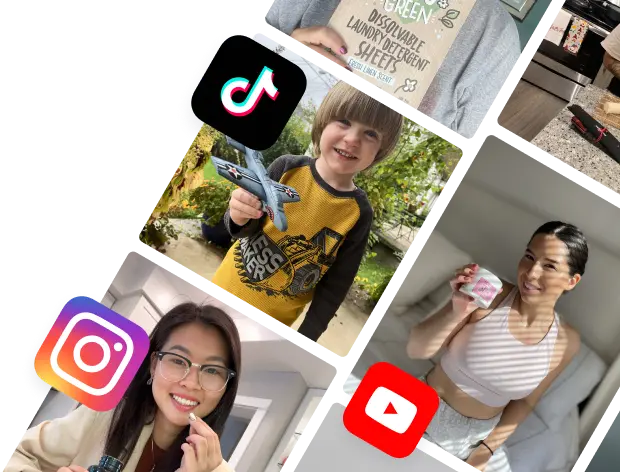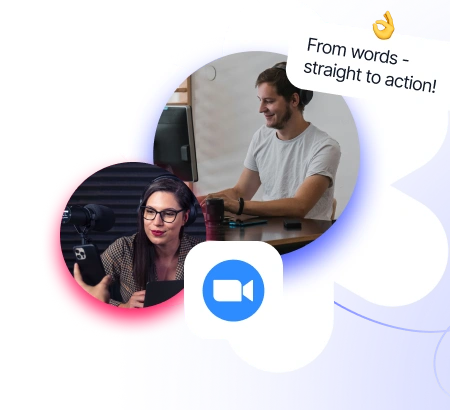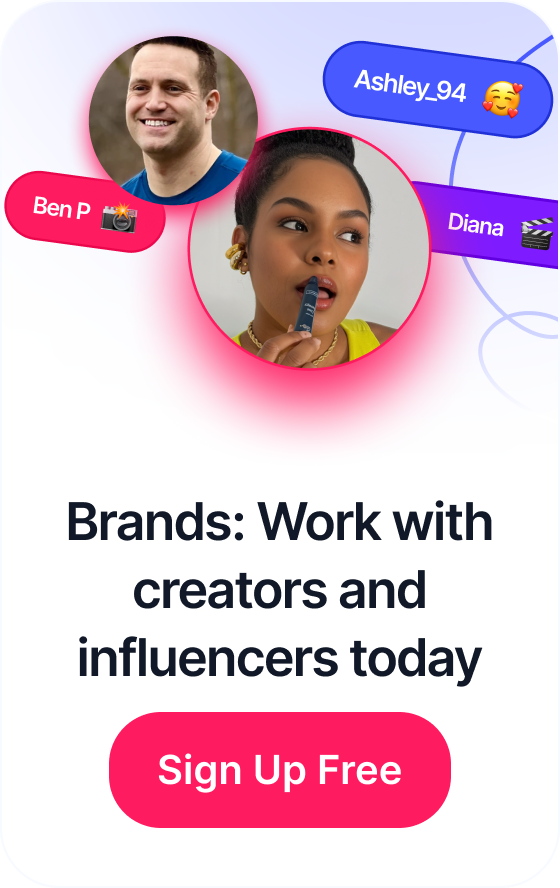 Boost Your Influencer Marketing ROI Today
Boost Your Influencer Marketing ROI Today
So, you’ve launched a campaign and the numbers are rolling in. Views, clicks, impressions… it’s easy to get lost in a sea of data. But if you want to know how many actual people your brand is connecting with, you need to focus on one metric above all others: reach.
Simply put, reach is the total number of unique individuals who have seen your content. It’s not about how many times your ad was displayed, but how many distinct pairs of eyes saw it. Think of it as your campaign's true headcount.
Table of Contents
What Reach Really Means for Your Brand
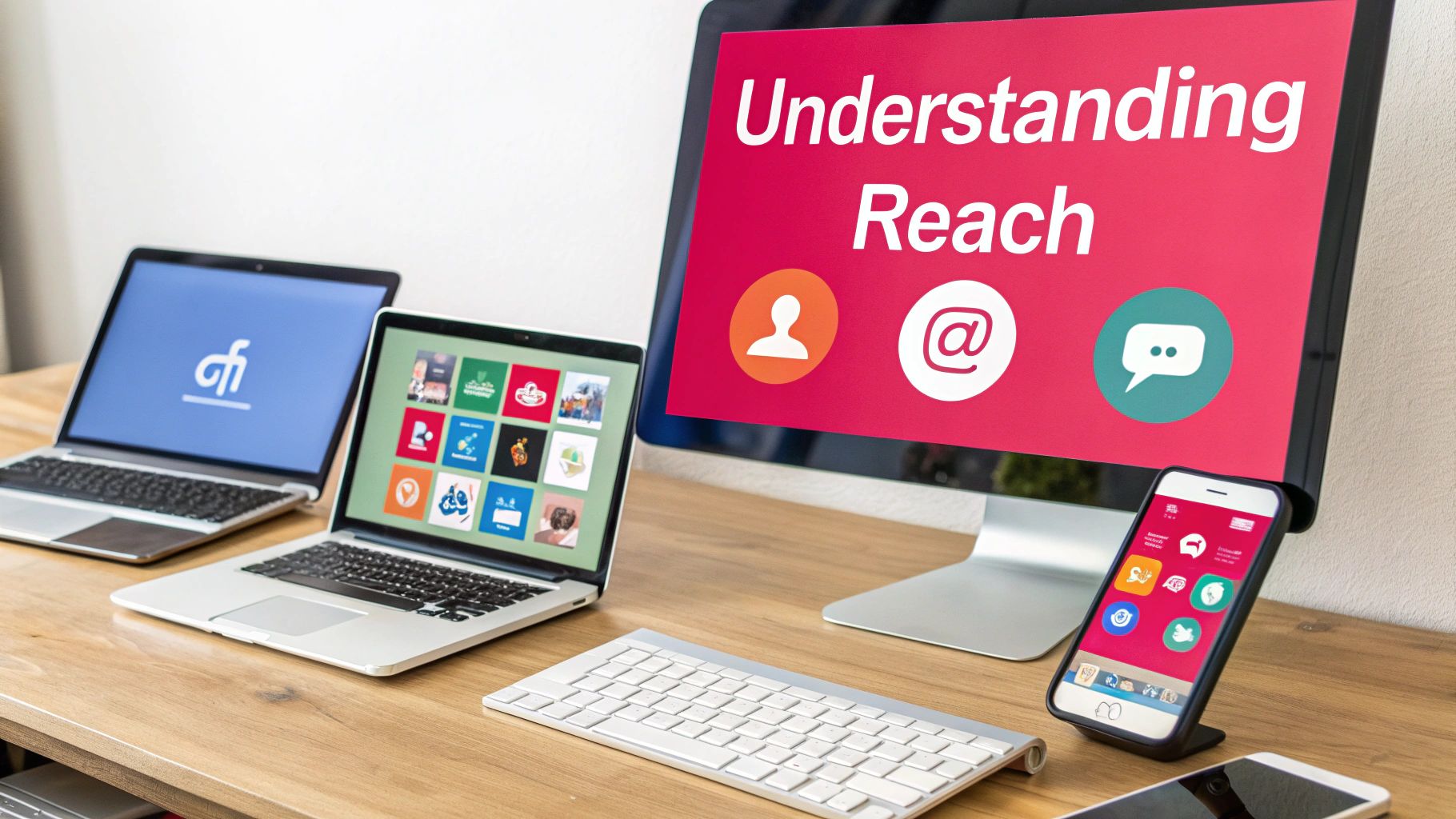
Let's cut through the jargon. Reach isn't just another number to report—it's the real count of people your brand has managed to touch. To really get a grip on this, it's vital to understand the difference between Instagram impressions and reach, as this is where most of the confusion happens.
Imagine you run an ad and one person sees it three times. Your analytics will show a reach of one but three total impressions. This distinction is the bedrock of effective campaign analysis.
Reach answers the question: "How many unique people saw my content?"
Impressions answer: "How many times was my content seen in total?"
Grasping this difference is what stops you from mistaking repetitive views from a small, hyper-engaged group for genuine audience growth. It helps you focus on expanding your actual audience instead of just hammering the same people over and over.
Why This Distinction Is Crucial
Separating reach from other vanity metrics is essential for understanding the true size and impact of your audience. When you know how many unique individuals you're connecting with, you can make much smarter decisions about where to put your time and money.
For instance, if you see sky-high impressions but your reach is lagging behind, that’s a red flag. It likely means your ads are being shown repeatedly to the same users, which is a fast track to ad fatigue. Nobody likes being bombarded.
This insight is particularly valuable for campaigns on visual-heavy platforms. For example, brands running a TikTok affiliate programme must track unique reach to gauge how effectively their creators are introducing their products to fresh, new audiences—not just the same old followers.
Key Metrics at a Glance
To make sure we're all on the same page, it helps to have a quick reference. These three metrics—reach, impressions, and frequency—work together to paint a full picture of your campaign's performance.
Here’s a simple table to keep them straight:
| Metric | What It Measures | Simple Analogy |
|---|---|---|
| Reach | The total number of unique people who saw your content. | The number of individual people who attended a concert. |
| Impressions | The total number of times your content was viewed. | The total number of tickets scanned at the gate, including people who left and came back. |
| Frequency | The average number of times one person saw your content. | How many times, on average, each attendee saw the promotional posters inside the venue. |
By keeping an eye on all three, you get a much richer story. But when your goal is growth, reach is your north star. It shifts your focus from just racking up views to building a wider, more authentic audience that can actually move the needle for your brand.
The Fundamental Formula for Calculating Reach
So, how do you actually calculate reach in a way that gives you something you can work with? While every platform has its own little quirks, the basic logic is surprisingly consistent. Marketers often fall back on one key formula to get a handle on their audience size, especially when the platform doesn't just hand you the unique user count on a silver platter.
The core idea connects three metrics you're probably already familiar with: reach, impressions, and frequency.
Reach = Impressions ÷ Frequency
Don't let the simplicity fool you; this little equation is incredibly powerful. It helps you figure out the number of unique people who saw your content by taking the total number of views (impressions) and dividing it by the average number of times each person saw it (frequency). This is a foundational way to calculate social media reach, and it’s critical for separating total views from the actual number of individuals you've connected with. If you want to dive deeper, you can explore how to calculate social media reach in more detail.
Putting the Formula into Practice
Let's make this real. Imagine you just wrapped up a social media campaign that pulled in 20,000 impressions. Your analytics also tell you that, on average, people saw your content 2.5 times—that’s your frequency.
Plugging those numbers into our formula:
- Reach = 20,000 (Impressions) ÷ 2.5 (Frequency)
- Reach = 8,000 unique people
Boom. This simple calculation shows that your campaign didn't just get 20,000 views; it actually connected with 8,000 distinct individuals. That's a much more useful piece of information. It tells you that you're hitting a broad audience instead of just serving your ad over and over to a small, isolated group.
This flow shows how all the pieces come together to give you a clear reach number.
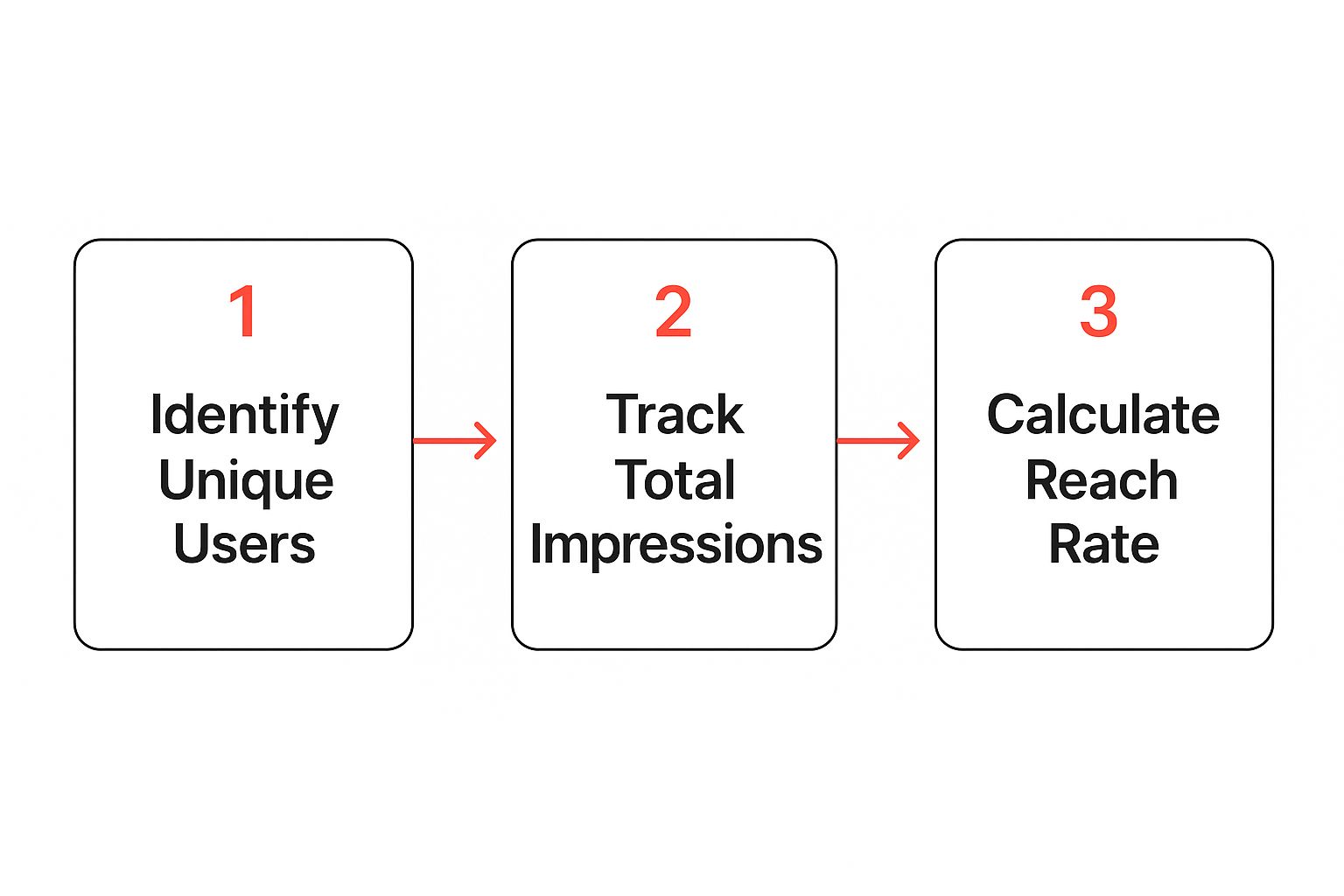
While raw reach tells you about audience size, a great next step is to look at engagement rate. After all, what good is reaching people if they don't interact? A tool like a Twitter engagement rate calculator can give you precise insights into how your audience is responding. Getting comfortable with this basic formula is the first step toward really fine-tuning your strategy and making sure your budget is working as hard as it can.
Using Reach Rate to Benchmark Your Performance
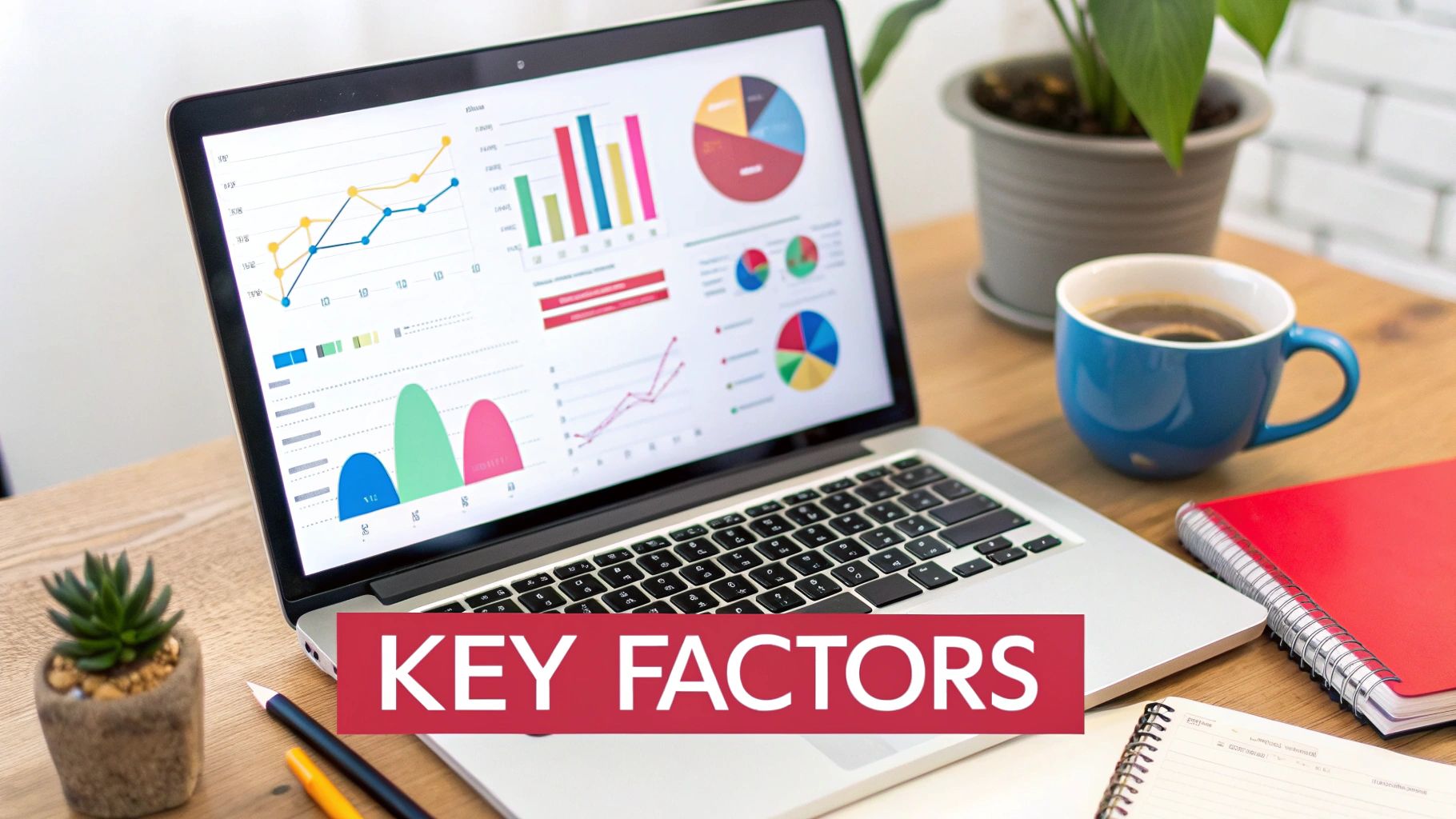
While absolute reach tells you how many people saw your content, a far more powerful metric reveals how well you’re connecting with the audience you've already built. This is where reach rate enters the chat, shifting your focus from raw numbers to real-world performance.
It helps you answer a much more strategic question: "What percentage of my existing followers am I actually reaching with my posts?" After all, getting your content in front of your own fans is the first big hurdle. You can learn more about how different social media reach calculations shape your strategy and why this distinction matters.
Calculating Your Reach Rate
The formula itself is refreshingly simple, but the insight it provides is huge. It puts your reach into perspective by measuring it against your follower count, giving you a clear benchmark for how your content is doing.
Reach Rate = (Total Reach ÷ Total Followers) x 100
This percentage cuts through the noise. It tells you exactly how effective your content is at grabbing the attention of people who have already raised their hands to hear from you. Think of it as a direct grade on your content's relevance and its ability to play nicely with the platform's algorithm.
Let’s run a quick example. Imagine your company's LinkedIn page has 10,000 followers. You publish a new article and it reaches 2,000 unique people.
- Reach Rate = (2,000 ÷ 10,000) x 100
- Your reach rate for that post is 20%.
Putting Reach Rate to Work
That 20% isn't just a number to stick in a report; it's a powerful diagnostic tool. A consistently low reach rate can be a major red flag, telling you that your content isn't hitting the mark or that your posting schedule is off. On the flip side, a high reach rate is a clear sign you’re onto something good.
Here's how you can put this metric to work immediately:
- Compare content formats: Do your videos get a higher reach rate than static images or carousels?
- Pinpoint winning topics: Which themes or pillars consistently connect with a bigger slice of your audience?
- Benchmark against your industry: How does your 20% rate stack up against what competitors are seeing in your niche?
By tracking reach rate, you stop just counting eyeballs and start truly understanding what captures your audience's attention. This allows you to stop guessing and start refining your strategy for maximum impact.
Organic, Paid, and Viral Reach: The Three Flavors of Exposure

Here's a hard truth: not all reach is the same. To really get a grip on how your content is performing, you have to break down your total reach into its three core ingredients. Think of it like a recipe—each component adds a different flavor and texture to the final dish.
Looking at them separately is the only way to diagnose what's working, what's not, and where to put your energy next. Each type tells a totally different story about your content's journey.
The Three Pillars of Reach
First, you have organic reach. This is the number of unique people who see your content naturally, without you spending a dime on promotion. These are your followers, plus anyone who stumbles across your post through search, the "For You" page, or other non-paid discovery features. Honestly, it's the truest measure of your content's raw quality and relevance to your audience.
Next up is paid reach, which is exactly what it sounds like. It’s the audience you pay to get in front of through boosted posts, targeted ads, and other campaigns. This is where you get to be strategic, zeroing in on specific demographics and interests that match your ideal customer profile. It's reach on your terms.
And finally, we have viral reach—the one everyone chases. This is the magic that happens when other people do the work for you. It's the number of unique users who see your content because someone else shared it, tagged a friend, or sent it to a group chat. It’s pure, digital word-of-mouth.
A smart marketing strategy never puts all its eggs in one basket. The real momentum comes from the sweet spot where organic quality (great content), paid targeting (smart ads), and viral potential (shareability) all work together.
Is your growth coming from a loyal community (organic), a sharp ad budget (paid), or content that's just too good not to share (viral)? Knowing the answer is everything.
To see this data clearly, you need a way to slice and dice the numbers. A powerful social media analytics dashboard is your best friend here. It gives you the segmented view you need to understand what's really driving your growth so you can do more of it.
Key Factors That Actually Influence Your Reach
Ever wonder why some of your posts take off like a rocket while others just… don't? It can feel random, but it's really not. To get seen, you need to understand what the platform algorithms are actually looking for.
Moving past the simple formulas, the real key is figuring out how these platforms calculate reach in the first place. Once you get that, you can stop throwing content at the wall and start building a strategy that gives the algorithms exactly what they want.
The secret to great reach isn't about gaming the system. It's about creating content so valuable that the system has no choice but to share it. Early engagement is a powerful signal that tells the algorithm you've posted a winner.
Think about it from the algorithm's perspective. When a post gets a quick burst of likes, comments, and shares, it's a huge sign that people find it interesting. This initial flurry of activity acts like social proof, essentially telling the platform, "Hey, people like this! Show it to more users!"
The Core Elements of Algorithmic Favor
While every platform guards its algorithm like a secret recipe, they all fundamentally reward the same thing: content that keeps people on their app. This boils down to a few core elements you can actually control.
Nailing these basics can be the difference between a few hundred views and a few thousand.
- Content Quality: This is your ticket to the game. High-resolution images, clear audio, and genuinely useful information are table stakes. Platforms can spot low-quality stuff and will almost always suppress it.
- Audience Engagement: This is the big one. Posts that rack up high interaction rates—we're talking likes, comments, shares, and saves—are seen as more relevant. The more people engage, the more the algorithm will show it.
- Posting Time: You wouldn't open a shop when everyone's asleep, right? The same logic applies here. Post when your audience is most active to give your content the best shot at getting that crucial, immediate traction. Dive into your analytics to find your brand's unique "golden hours."
Another killer strategy is weaving in user-generated content (UGC). There's nothing more powerful than real customers showcasing your products. It's authentic, it builds trust, and it drives the kind of engagement that fuels incredible reach.
If you're just getting started with this approach, learning how to create UGC content can give you a major leg up. By focusing on these pillars, you can move from guessing to creating content that genuinely connects and consistently performs.
Alright, let's tackle those nagging questions about reach that always seem to pop up once you start digging into your analytics. Getting a handle on these can really help you fine-tune your strategy and see how you're measuring up.
What Is a Good Reach Rate, Anyway?
This is the million-dollar question, and honestly, there's no single "right" answer. What's "good" really hinges on your industry, how big your audience is, and which platform you're on. But we can look at some industry benchmarks to get a feel for what's solid.
- Facebook: If you're hitting around a 6% reach rate on your Facebook posts, you're doing pretty well.
- Instagram: The goalpost moves a bit here. For a standard in-feed post, shooting for an 8% reach rate is a great target. For Stories, the numbers are naturally lower—even a 1% reach rate is considered decent.
A quick heads-up: it's totally normal for accounts with huge followings to see lower percentage rates. The bigger you get, the harder it is to reach a high percentage of your audience. So if you're hitting or even beating these numbers, give yourself a pat on the back. You're on the right path.
Reach or Engagement: Which One Matters More?
Ah, the classic marketing debate. It’s like asking if you need an engine or wheels on a car—you really need both, but you might focus on one over the other depending on where you're trying to go.
The most important debate for any marketer is often whether to focus on expanding reach or driving deeper engagement. Both are critical, but they serve different goals.
Think of it this way: reach is all about brand awareness. It’s your top-of-funnel play. If you're launching a new product or just trying to get your name out there, reach is your number one priority. You need to get in front of as many new, relevant eyeballs as you can.
On the other hand, if your goal is to build a rock-solid community or drive sales from the followers you already have, that’s when engagement takes center stage. High engagement is a massive signal that your content is hitting the mark, which builds the kind of loyalty and trust that leads to conversions.
A smart strategy uses both, but the real secret is knowing when to lean more heavily on one to crush your specific campaign goals.
Ready to stop guessing and start connecting with creators who can genuinely expand your reach? JoinBrands makes it easy to find and collaborate with over 250,000 influencers and UGC creators who can amplify your message. Find the perfect partners to boost your visibility at JoinBrands.

